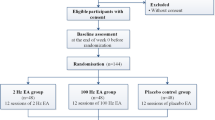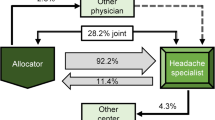Abstract
Objective
To observe the clinical effect of penetrating moxibustion on migraine without aura (MO) patients.
Methods
Totally 60 MO patients from the Acupuncture Clinic of the Third Affiliated Hospital of Henan University of Chinese Medicine were collected from November 2015 to February 2017. All patients were assigned to a treatment group and a control group using a random number table, 30 cases in each group. The treatment group was treated with penetrating moxibustion, and the control group was treated with mild moxibustion, thrice a week for 4 consecutive weeks. The total effective rate, Visual Analogue Scale (VAS) scores, headache intensity, and Migraine Specific Quality of Life Questionnaire (MSQ) scores of patients after treatment were compared between the two groups. The moxibustion sensation and reaction after moxibustion were observed, and the adverse reactions were evaluated. All patients were followed up at 4 and 16 weeks after treatment.
Results
The total effective rate of the treatment group was significantly higher than that of the control group (93.33% vs. 80.00%, P<0.05). The improvement of VAS scores, headache intensity, and the role restrictive and role preventive scores in MSQ in the treatment group was better than those in the control group (P<0.05). The person-time of moxibustion sensations of itching, numbness and cold as well as flushing and sweating after moxibustion in the treatment group was all significantly higher than that in the control group (P<0.01). There was no significant difference in safety evaluation between the two groups (P>0.05).
Conclusions
Penetrating moxibustion can significantly relieve pain and improve quality of life of MO patients. After penetrating moxibustion, flushing and sweating of patients were obvious, and the curative effect was superior to the mild moxibustion.
Similar content being viewed by others
References
Bigal ME, Lipton RB. The epidemiology, burden, and comorbidities of migraine. Neurol Clin 2009;27:321–334.
Gasparini CF, Smith RA, Griffiths LR. Genetic and biochemical changes of the serotonergic system in migraine pathobiology. J Headache Pain 2017;18:20.
Chen J, Zhao L, Zheng H, Li Y, Yang MX, Chang XR, et al. Evaluating the prophylaxis and long-term effectiveness of acupuncture for migraine without aura: study protocol for a randomized controlled trial. Trials 2013;14:361.
Zhao WS, Jang ZN, Shi H, Xu LL. Low-frequency electroacupuncture alleviates chronic constrictive injury-induced mechanical allodynia by inhibiting NR2B upregulation in ipsilateral spinal dorsal horn in rats. Chin J Integr Med 2019;25:454–461.
Gao XY. Penetrating moxibustion and its clinical application. Henan Tradit Chin Med (Chin) 2007;9:33–34.
Gao XY, Chen Y, Wang X, Chen XW, Gao Y, Yang XG, et al. Study of temperature changes during abdominal transmoxibustion. Chin Acupunct Moxibust (Chin) 2015;35:45–49.
Headache Classification Committee. The international classification of headache disorders. 2nd ed. Cephalalgia 2004;24:1–160.
Shi XM, ed. Acupuncture therapeutics. 6th ed. Shanghai: Shanghai Science and Technology Press;1998:91.
Zhao L, Ren YL, Liang FR. Analysis of characteristics of meridians and acupoints selected for treating migraine in past dynasties based on data excavation. Chin Acupunct Moxibust (Chin) 2009;29:467–472.
Zheng XY, ed. Guidelines for clinical research of new Chinese medicines (trial implementation). Beijing: China Medical Science and Technology Press; 2002:105.
Martin BC, Dba DSP, Sharfman MI, Adelman JU, Jhingran P. Validity and reliability of the migraine-specific quality of life questionnaire (MSQ version 2.1). Headache 2010;40:204–216.
Gao XY. Application of penetrating moxibustion. Chin Acupunct Moxibust (Chin) 2013;8:54–55.
Shang XK. Long-term mild moxibustion for gastrointestinal diseases. Shanghai J Acupunct Moxibust (Chin) 2004;23:22–23.
Zhang Y, Liu YX, Sun GJ. Effect of different moxibustion treatment time on immune function of yang deficiency mice. Hubei J Tradit Chin Med (Chin) 1998;20:53–55.
Gu YH, Jin HZ, Wu YC, Li SD, Ren JN. Effect of different moxibustion dosage on serum creatine kinase after exercise. J Nanjing Univ Tradit Chin Med (Chin) 2006;22:373–375.
Yao S. Study on the correlation between moxibustion promoting toning effect and TRPV1 [Dissertation]. Nanjing: Nanjing University of Traditional Chinese Medicine; 2014.
Hou ZM. Experimental study on anti-inflammatory and immune effect of moxibustion therapy. Chin Acupunct Moxibust (Chin) 1997;4:233–235.
Jiang JF, Wang LL, Xu B, Hu L, Song XG, Wu HJ. Anti-inflammatory: effect mechanism of warming-dredging in moxibustion. Chin Acupunct Moxibust (Chin) 2013;33:860–864.
Qi L, Liu HR, Yi T, Wu LY, Liu XR, Zhao C, et al. Warming moxibustion relieves chronic visceral hyperalgesia in rats: relations to spinal dynorphin and orphanin-FQ System. Evid Based Complement Alternat Med 2013;2013:920675.
Takayama S, Seki T, Watanabe M, Takashima S, Nitta SI. Changes of blood flow volume in the superior mesenteric artery and brachial artery with abdominal thermal stimulation. Evid Based Complement Alternat Med 2009;234–235.
Feng YM. Clinical study on the treatment of migraine with moxibustion by transcranial Doppler. Pract Clin J Integr Chin West Med (Chin) 2007;10:21–22.
Takayama Y, Itoi M, Hamahashi T, Tsukamoto N, Mori K, Morishita D, et al. Moxibustion activates host defense against herpes simplex virus type I through augmentation of cytokine production. Microbiol Immunol 2010;54:551–557.
Author information
Authors and Affiliations
Contributions
Gao XY directed the research and revised the manuscript. Gao L wrote the paper. Gao L, Xie J, Li X and Guo YJ collected and analyzed data. Zhang MM, Meng LY and Lin QT conducted acupuncture treatment. All authors agreed to publish the final version.
Corresponding author
Additional information
Conflict of Interest
The authors declared that there was no conflict of interest.
Rights and permissions
About this article
Cite this article
Gao, L., Xie, J., Li, X. et al. Effect and Safety of Penetrating Moxibustion in Treatment of Migraine without Aura: A Randomized Controlled Trial. Chin. J. Integr. Med. 27, 927–932 (2021). https://doi.org/10.1007/s11655-021-3327-4
Accepted:
Published:
Issue Date:
DOI: https://doi.org/10.1007/s11655-021-3327-4




